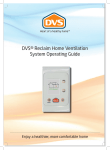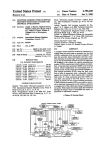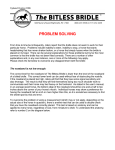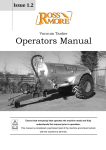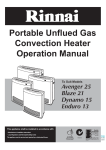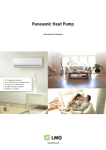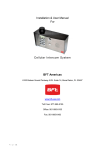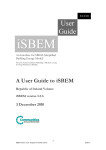Download G4 Classic Operating Guide
Transcript
DVS® Positive Pressure Home Ventilation System Operating Guide Enjoy a healthier, more comfortable home 76a Stoddard Road, Mt Roskill, Auckland 1041 | 285 Cashel Street, Christchurch 8011 Phone: 0800 387 387 | www.dvs.co.nz How to operate your DVS® home ventilation system Introduction Thank you for choosing a DVS home ventilation system for your home. A DVS ventilation system is able to make a significant difference to you and your family - creating a drier, fresher and healthier home, and improving your comfort and health. DVS has been supporting New Zealand for over 17 years with quality appliances and we’re proud to have our products used every day by many New Zealanders. What’s in this guide? Introduction 2 How it Works 2 The Main Screen 3 Basic functions Turning your DVS system off or on 4 Adjusting your Set temperature 4 Fan Boost option 4 Advanced functions 5 Adjusting the fan speed 5 Adjusting the Heat Retention fan 6 Adjusting the Heat Recovery fan 6 Adjusting the Air warmer or Tempervent settings 9 Automatic summer ventilation 9 Air Transfer All DVS ventilation systems are designed and made here in New Zealand to suit our unique climatic conditions and the needs of New Zealand homeowners. DVS’ reputation for innovative ventilation and health and comfort solutions has been built up over many years of research, development and customer feedback. Your standard DVS ventilation system features a state of the art fully automated control panel, with advanced functions and options, a user-friendly interface, and a quality German-made energy efficient fan. Optional extras such as automatic summer ventilation via an external vent, air preheating options via an air-warmer, or the unique DVS Tempervent, DVS Integrated Heat Transfer and full heat exchange ventilation are available as add-on extras. These operating guidelines contain helpful instructions on how to operate and adjust your system. Although your system has been configured, and the airflow and settings individually calibrated to the size of your home to run automatically, you will be able to easily fine tune the settings or adjust the “aggressiveness” of the system by adjusting the heat recovery and heat retention settings. How it Works 10 Other functions Setting the clock 13 View temperature history graphs 13 Filter service 13 Diagnostics 13 DVS Filters 14 Filter Replacement Instructions 15 How to get the best from your DVS 16 Recommendations 18 Frequent Questions and Answers 20 DVS offer a wide range of products 22 Updated 9 April 2013 Page 2 The Main Screen Basic Functions The wall panel normally displays the Main Screen, which shows: You can make the most common adjustments to your DVS system from the Main Screen. These are described on this page. • The current roof and house temperature (in the example below roof temperature is 25oC and house is 25oC). Turning your DVS system off or on • Your “Set temperature” (see page 4 for details). To turn the DVS system off or on, press and hold the Menu button for 5 seconds. If the system is switched off, the screen will display “SYSTEM STANDBY” and the fan and all accessories will be turned off. Press and hold the Menu button for 5 seconds to turn the DVS system on again. Current roof air temperature Current house temperature Your ‘set’ temperature Adjusting your Set temperature Up arrow button Down arrow button OK button Menu / On / Off button The Set temperature (called “Set temp” on the screen) is the temperature that the DVS system strives to achieve inside your house. For example, the system can increase the airflow if the roof space is warmer than the house and the house temperature is below the Set temperature. If there is no heat in the roof space, the system will not be able to achieve the Set temperature without additional heating. Set temp 20.5o To adjust the “Set temp” for your home: • Press the up or down arrow. (The display will change to show the Set temp only, while you’re adjusting it.) • Use the up and down arrows to adjust your required temperature. You can increase or decrease the Set temperature in half degree increments (e.g. 20o, 20.5o, 21o, 21.5o etc.). Fan Boost option Fan Boost • The status of the Air warmer or Tempervent (if fitted). Use the Fan Boost option if you want the fan to run at full speed for a period of time. This function is useful for clearing the house of extra moisture or smells, or to temporarily recover maximum heat from the roof space for heating purposes. Note that the fan may be noisier at this speed. • The status of the Automatic summer ventilation functions (if fitted). To set the length of time for Fan Boost, or to turn it off: 90min • Whether the filter is due for replacement. • Press and hold the up arrow for 3 seconds or more. This takes you to the FAN BOOST screen. • Use the down arrow to select the amount of time you want Fan Boost to run for (15, 30, 60 or 90 minutes), or to turn it OFF. • Press OK. • Press the Menu button repeatedly until you return to the Main Screen. If they are in use, the Main Screen will also show: Note: If the LCD display appears dim, press any button on the keypad to activate the backlight. Page 3 OFF 15min 30min 60min Page 4 Adjusting the Heat Recovery Function Advanced Functions More advanced functions of your DVS system are accessed via the Menu button. These include: • Fan speed • Heat Recovery mode • Air warmer or Tempervent operation (if • Automatic summer ventilation operation fitted) (if fitted) • Heat Retention mode • Air transfer operation (if fitted) • Clock • Temperature history • Replace filter • Diagnostics Adjusting the fan speed Your system has been configured so the airflow and settings are individually calibrated to the size of your home and will run at these settings automatically. However, you are able to easily fine tune the fan speed to optimise condensation or climate control to better suit your needs. Fan speed tuning allows you to adjust the fan speed to a level higher or lower than the pre-set calibrated level (represented by the ‘0%’ setting). To adjust the fan speed: • • • • • • Press the Menu button briefly. Use the down arrow to select Fan settings and press OK. Use the down arrow to select Fan speed and press OK. Use the up or down arrow to change the fan speed (from -15% to +15%). Press OK to confirm the fan speed. Press the Menu button repeatedly until you return to the Main Screen. Fan Speed +15% 0% -15% Allows you to fine tune the fan speed to your house and climate Adjusting the Heat Retention Function You can adjust the way your DVS system responds to situations where the roof air is colder than the house temperature (winter nights). Heat retention comes into play when the system senses that the room is warmer than the roof space, and slowing the system down will keep the room temperature closer to the desired Set temperature. In the Off position the Heat retention function is off. At other levels of Heat retention the fan speed decreases in proportion to the difference between the roof temperature and the Set temperature. Selecting a higher setting decreases the fan speed more quickly to a low level. Note: A high Heat retention setting may compromise the ability of the DVS system to control condensation. • • • • Press the Menu button briefly. Use the down arrow to select Fan settings and press OK. Use the down arrow to select Heat retention and press OK. Use the up and down arrows to adjust the Heat retention tuning - from OFF through to MAX. • Note: The higher the setting (closer to MAX) the quicker the fan speed will drop. • Press OK to confirm your selection, then press the Menu button repeatedly until you return to the Main Screen. Page 5 You can adjust the way your DVS system responds to situations where the roof air is hotter than the house temperature (autumn, summer and spring days). Heat recovery comes into play when the system senses that heat is available in the roof space that can be used to get closer to the desired Set temp more quickly if the system speeds up. In the OFF position the Heat recovery function is off. At other levels of Heat recovery, the fan speed increases in proportion to the difference between the roof temperature and the room temperature. Selecting a higher setting increases the fan speed more quickly to a high level. • • • • Press the Menu button briefly. Use the down arrow to select Fan settings and press OK. Use the down arrow to select Heat recovery and press OK. Use the up and down arrows to adjust the Heat recovery tuning - from OFF through to MAX. • Note: The higher the setting (closer to MAX) the quicker the fan speed will increase. • Press OK to confirm your selection, then press the Menu button repeatedly until you return to the Main Screen. Heat Recovery MAX OFF Increasing this setting raises the fan speed on sunny cooler days. Adjusting the Air warmer or Tempervent settings Note: The Air warmer or Tempervent(s) will not function if the room set temperature has already been achieved or the roof temperature is equal to or warmer than the room set temperature. The Air warmer or Tempervent is designed to pre-warm the air in the system before bringing it into the house. It is designed to take the chill off incoming air during the cooler months, not to warm your home like a central heating system. It can be set to work manually or automatically. Note: This feature will only activate in the control system if it has been installed as an optional extra. • In Manual mode, you can set the Air warmer or Tempervent to be on for a specified period of time, or off. • In Automatic mode you can set the Air warmer or Tempervent to come on: • at certain times (timer), or • when the air in the roof falls below a specified temperature, or • a combination of both (i.e. you can set the Air warmer or Tempervent to come on when the air in the roof falls below the temperature you specify, during the “On” part of the timer’s cycle). Air Warmer Manual [0] Roof Temp Timer Temp & timer Select the desired operating mode. Only one mode can be used at any one time. Manual mode Heat Retention MAX OFF Increasing this setting reduces the fan speed during winter months. To set the Air warmer or Tempervent to be on or off manually: Manual Time Set • • • • Press the Menu button briefly. Use the down arrow to select Air warmer or Tempervent and press OK. Use the down arrow to select Manual [0] and press OK. Use the up and down arrows to select the amount of time you want the Air warmer or Tempervent to run for (30, 60, 90 or 120 minutes), or to turn it OFF. • Press OK to confirm your selection, then press the Menu button repeatedly until you return to the Main Screen. OFF 30min 60min 90min 120min Air warmer runs for one of the above times and then turns off. Automatic mode using the timer Automatic mode using the roof temperature To set the timer to switch the Air warmer or Tempervent on and off automatically at specified times on specified days: Timer Set Up • • • • Press the Menu button briefly. Use the down arrow to select Air warmer and press OK. Use the down arrow to select Timer and press OK. Use the up and down arrows to select the timer that you want to programme (Timer 1, 2, 3 or 4) and press OK. Timer 1 MTWTFSS 00:00 - 00:00 Timer 2 MTWTFSS 00:00 - 00:00 Timer 3 MTWTFSS 00:00 - 00:00 Timer 4 MTWTFSS 00:00 - 00:00 Note: Timers are organised so that “On” times have priority over “Off times”. For example, if Timer 1 is set to be “Off” when Timer 3 is set to be “On”, then Timer 3 will override Timer 1 and the Air warmer or Tempervent will be on. As timers are set by day as well as time no timer will work if its off time is set past 11:45 pm. Ie to have the timer on from 5pm till 7 am the next morning set timer one from 17:00 – 23:45 and timer two set from 00:00 – 07:00. The heater will turn off from 231:45 till midnight and then turn back on until 7:00am To do this: • Use the down arrow to highlight the required day, and press OK to change it to “On” (pressing OK again changes it back to “Off”), and • repeat until you have selected all the days you want this timer to apply to. • Press the Menu button to return to the “Set timer #” screen. • Use the down arrow to select “On time” and press OK. You will be taken to the “SET TIME” screen. Mon Tue Wed Thu Fri Sat Sun On Off Off Off Off Off Off Set timer 1 Days = MTWTFSS On time Off time • • • • Press the Menu button briefly. Use the down arrow to select Air warmer or Tempervent and press OK. Use the down arrow to select Roof temp and press OK. Use the up and down arrows to set the temperature (range is 0oC to 25oC. Factory default is 15oC) and press OK. • If the temperature of the air in the roof falls below this temperature, the Air warmer or Tempervent will switch on automatically. • Press the Menu button repeatedly until you return to the Main Screen. Roof temp set 15.0o Air warmer turns on anytime the roof is colder than this temp Automatic mode using both timer and roof air temperature Select days • Use the down arrow to select Days = and press OK. • This takes you to the “Select days” screen. • Select the days that you want this timer to apply to. To set the Air warmer or Tempervent so that it switches on automatically when the air in the roof drops below a specified temperature: To set the Air warmer or Tempervent so that it switches on automatically when the air in the roof drops below a specified temperature, and also switches on and off at the times you have specified: • • • • • • Firstly, set the timer(s) as described on page 7 and return to the main screen. From the Main Screen, press the Menu button briefly. Use the down arrow to select Air warmer or Tempervent and press OK. Use the down arrow to select Temp & timer and press OK. Set the roof air temperature (as described above) and press OK. Press the Menu button repeatedly until you return to the Main Screen. Note: If you select Temp & timer, the Air warmer or Tempervent will only come on if: • the air temperature in the roof falls below the temperature you have set, and • it is during the “ON” part of the timer’s cycle. 00:00 00:00 • Use the up and down arrows to select the hour when you would like the timer to switch the Air warmer or Tempervent ON, and press OK. (Note: Timers use 24 hour clock.) • Use the up and down arrows to select the number of minutes past the hour (15, 30 or 45) when you would like the timer to switch the Air warmer or Tempervent ON, and press OK. You will return to the “Set timer #” screen. • Use the down arrow to select “Off time” and press OK. You will be taken to the “SET TIME” screen. Set Time • Use the up and down arrows to select the hour when you would like the timer to switch the Air warmer or Tempervent OFF, and press OK. • Use the up and down arrows to select the number of minutes past the hour Adjust hours: (15, 30 or 45) when you would like the timer to switch the Air warmer or 01:00 Tempervent OFF, and press OK. You will return to the “Set timer #” screen. • Press the Menu button to return to the “Timer setup” screen. From here you can set further timers if required. • When you are finished, press the Menu button repeatedly until you return to the Main Screen. Page 7 Page 8 Automatic summer ventilation (if fitted) Air Transfer (if fitted) The purpose of Automatic summer ventilation is to deliver a continuous supply of fresh filtered air from outside the roof space by automatically changing the air source to draw from the external vent when the roof space air becomes too warm. This means you can ventilate your home throughout the summer months without the need to leave windows open during the day or night (thus reducing pollen, dust and insects in your home). The purpose of air transfer is to deliver a supply of warm air from the warm room and delivering this to the colder part of the house by automatically changing the air source to draw from the warm room with excess heat (eg. The living room with a wood burner). In air transfer mode the system will not ventilate, but will merely redistribute existing air around the house. This function lets you set when and at what temperature the Air transfer mode will switch on. If you have this option installed then you will also have a separate temperature sensor near your home’s main heat source. In some weather conditions the outside air is too warm to ventilate the home. In this instance the system will behave normally and reduce delivery to an ‘idle’ so as not to warm the home. The Air Transfer function is reactive to the room set temperature and the actual room temperature. This is regardless of the ‘mode’ selected. So; if the room temperature at the control panel is equal to or warmer than the set temperature (this is the main system set temperature, not the automatic mode temperature for air transfer, see page 12) then little or no air will be transferred. The Automatic summer ventilation function can be set to work manually or automatically. Note: This is an optional extra and will not appear on the control panel unless installed. • In Manual mode you can set the Automatic summer ventilation function to be on for a fixed time, from 30 minutes to 2 hours. After this time the Automatic summer ventilation will automatically switch off. • In Auto mode you can set the Automatic summer ventilation function to switch on automatically if the temperature in your home rises above your “Set temperature”. The Air transfer function can be set to work manually or automatically. • In Manual mode you can set the Air transfer function to be on for a fixed time, from 30 minutes to 2 hours. After this time the Air transfer will automatically switch off. Manual mode • In Automatic mode you can set the Air transfer function to come on: To switch the Automatic summer ventilation function on or off manually: Press the Menu button briefly. Use the down arrow to select Summer vent and press OK. Use the down arrow to select Manual [0] and press OK. Use the up and down arrows to select the amount of time you want the Automatic summer ventilation function to run for (30, 60, 90 or 120 minutes), or to turn it OFF. • Press OK to confirm your selection, then press the Menu button repeatedly until you return to the Main Screen. To switch the Air transfer function on or off manually: To set the Automatic summer ventilation function so that it switches on automatically if the temperature in your home rises above your Set temperature: Auto temp set Page 9 20.5 Select the desired air transfer mode. Only one mode can be used at any one time. Manual mode Automatic mode Press the Menu button briefly. Use the down arrow to select Summer vent and press OK. Use the down arrow to select Auto and press OK twice. The automatic summer ventilation function will now work based on the “Set temperature” set from the Main Screen. • Press the Menu button repeatedly until you return to the Main Screen. Manual [0] Temperature Timer Temp & timer • at certain times (timer), or • above a certain temperature (according to the sensor), or • a combination of both (i.e. you can set the Air transfer to come on above a certain temperature during the “On” part of the timer’s cycle). • • • • • • • • Air Transfer o • • • • Press the Menu button briefly. Use the down arrow to select Air transfer and press OK. Use the down arrow to select Manual [0] and press OK. Use the up and down arrows to select the amount of time you want the Air transfer to run for (30, 60, 90 or 120 minutes), or to turn it OFF. • Press OK to confirm your selection, then press the Menu button repeatedly until you return to the Main Screen. Manual time set OFF 30min. 60min. 90min. 120 min. Air transfer runs for one of the above times and then turns off. Summer ventilation will switch on above the set temperature Page 10 Automatic mode using the timer To set the timer to switch the Air transfer function on and off automatically at specified times on specified days: • • • • Press the Menu button briefly. Use the down arrow to select Air transfer and press OK. Use the down arrow to select Timer and press OK. Use the up and down arrows to select the timer that you want to programme (Timer 1, 2, 3 or 4) and press OK. Automatic mode using the source air temperature Timer Set Up Timer 1 MTWTFSS Timer 2 MTWTFSS Timer 3 MTWTFSS Timer 4 MTWTFSS Note: Timers are organised so that “On” times have priority over “Off times”. For example, if Timer 1 is set to be “Off” when Timer 3 is set to be “On”, then Timer 3 will override Timer 1 and the Air transfer will be on. • Use the down arrow to select Days = and press OK. This takes you to the “Select days” screen. • Select the days that you want this timer to apply to. To do this: • use the down arrow to highlight the required day, and press OK to change it to “On” (pressing OK again changes it back to “Off”), and • repeat until you have selected all the days you want this timer to apply to. • Press the Menu button to return to the “Set timer #” screen. • Use the down arrow to select “On time” and press OK. You will be taken to the “SET TIME” screen. • Use the up and down arrows to select the hour when you would like the timer to switch the Air transfer on, and press OK. (Note: Timers use 24 hour clock.) • Use the up and down arrows to select the number of minutes past the hour (15, 30 or 45) when you would like the timer to switch the Air transfer on, and press OK. You will return to the “Set timer #” screen. • Use the down arrow to select “Off time” and press OK. You will be taken to the “SET TIME” screen. • Use the up and down arrows to select the hour when you would like the timer to switch the Air transfer off, and press OK. • Use the up and down arrows to select the number of minutes past the hour (15, 30 or 45) when you would like the timer to switch the Air transfer off, and press OK. You will return to the “Set timer #” screen. • Press the Menu button to return to the “Timer setup” screen. From here you can set further timers if required. When you are finished, press the Menu button repeatedly until you return to the Main Screen. Page 11 On Off Off Off Off Off Off Set timer 1 Days = MTWTFSS On time Off time • • • • Press the Menu button briefly. Use the down arrow to select Air transfer and press OK. Use the down arrow to select Temperature and press OK. Use the up and down arrows to set the temperature (range is 0oC to 25oC. Factory default is 15oC) and press OK. If the temperature of the air near the main heat source rises above this temperature the Air transfer function will switch on automatically. Select days Mon Tue Wed Thu Fri Sat Sun To set Air transfer function so that it switches on automatically when the air near the main heat source rises above a specified temperature: 00:00 00:00 • Press the Menu button repeatedly until you return to the Main Screen. Automatic mode using both timer and source air temp To set Air transfer function so that it switches on automatically when the air near the main heat source rises above a specified temperature, and also switches on and off at the times you have specified: • • • • • • Firstly set the timer(s) as described in the previous pages. Then, from the Main Screen, press the Menu button briefly. Use the down arrow to select Air transfer and press OK. Use the down arrow to select Temp & timer and press OK. Set the source air temperature (as described above) and press OK. Press the Menu button repeatedly until you return to the Main Screen. Note: If you select Temp & timer, the Air transfer will only come on if: • the air temperature near the main heat source rises above the temperature you have set, and • it is during the “ON” part of the timer’s cycle. Set Time Adjust hours: 01:00 Page 12 DVS Filters Setting the clock To set the clock to the correct time on the DVS system: • • • • Press the Menu button briefly. Use the down arrow to select Utilities and press OK. Use the down arrow to select Set clock and press OK. Use the up and down arrows to select the correct day of the week, and press OK. • Use the up and down arrows to select the correct hour (uses 24 hour clock), and press OK. • Use the up and down arrows to select the correct minutes, and press OK. Set Clock Adjust hours: Wed 12:16 We recommend that you replace the air filter(s) on your DVS system approximately every 12 months. A blocked air filter can cause poor performance from your DVS, and may result in equipment damage or failure, and shorten the life of your DVS system. We supply replacement filters, which can be fitted by yourself, or can be fitted by our service technicians in conjunction with a service check of your DVS system. Please contact DVS on 0800 387 387 to organise a service technician to do this for you. Alternatively follow the instructions provided to change the filters yourself. FOR YOUR SAFETY Please take special care when climbing into your roof space, and while in the roof space walk only on load-bearing roof beams or trusses. We suggest you ensure another person is in the house or tell a neighbour you are climbing into your roof space so that you can get assistance quickly if you slip or have an accident. View temperature history graphs You can display a graph showing the past day’s and week’s temperatures for your house and the roof. To access these graphs: • • • • • • Switch your DVS SYSTEM OFF at the control panel. Press the Menu button briefly. Use the down arrow to select Utilities and press OK. Use the down arrow to select Temp. graphs and press OK. “Temp graph 1” will display on the screen (showing the previous 24 hours). Press OK again to display “Temp graph 2”, which shows the previous 7 days. Press the Menu button Disconnect the DVS Air Handling Unit from the house supply by unplugging the 3-pin plug before servicing or changing the air filter. Use only a dry cloth when cleaning the unit. Do NOT remove, open or attempt to service any DVS equipment while it is connected to the house power supply. Filter service The DVS range of affordable air filters meet international air quality ratings and remove dust, pollen, plant spores and other airborne material from your air supply prior to delivering this into your home. The filter reminder will appear on the Main Screen when the filter service timer has counted down to 0 days. This is a reminder that your filter should be changed or serviced. Please call DVS on 0800 387387 to arrange for a filter service or replacement filter. To reset the filter reminder press the up arrow, then OK. 25o 28o Set temp 22.5o Replace air filter Note: It is recommended that the filter is changed every 12 months in order to ensure proper operation of the fan and in order to prevent build up of dust, pollen and bacteria which could be harmful to your health. Diagnostics The diagnostic screen (available under the Utilities menu) displays any errors or faults with your DVS system, as well as current fan speed and RPM (revolutions per minute). Page 13 For more information contact DVS on 0800 387 387 or visit www.dvs.co.nz Standard Filter Commonly used in domestic and commercial ventilation systems eliminating at least 80% and up to 95% visible airborne pollen and dust particles. High Grade F6 Filter Commonly used in hospitals, dairy and food processing factories, eliminating at least 99% of visible airborne pollen and dust particles. IMPORTANT INFORMATION You need to replace your filter every 12 months with a genuine DVS® branded filter to maintain correct operation of the system. The 5 Year Parts and Labour Warranty on your DVS® system is dependant on you doing so during its period of validity. Page 14 Filter Replacement Instructions How to get the Best from Your DVS System. Before you start: Your DVS Home Ventilation System has been configured, installed and calibrated to best meet your family’s needs and the size and layout of your home. However, in order to get the best results it is important that you, the homeowner, follow these General Guidelines. Switch your DVS off at the control panel by holding down the Menu On/Off key. This will put the system into standby. • Before going into the roof space to change your DVS filter ensure that you have the required filter and a second filter if the optional Summer ventilation or Integrated heat transfer is fitted. You also need a clean dry cloth, and a good torch or safety lamp. • With a pair of strong scissors (recommended) or sharp utility knife, carefully cut the plastic tie holding the used filter to the black plastic ring of the DVS Air Handling Unit or loosen the pull cord, which ever is applicable. Pull away the used filter. • Use the dry cloth to wipe any fine dust from the Air Handling Unit impellor and inside of the inlet flange. • Pull the new filter over the inlet flange, tighten the new filter around the inlet flange using the pull cord and toggle. • Repeat for each filter. • • Please note that in the vast majority of cases, dust around the ceiling diffuser is the result of dust already inside the home being attracted by tiny electrostatic charges that build up on the surface of the ceiling or diffuser as the incoming air brushes past these surfaces. Turn on your DVS control panel • • • • • • Press Menu Use the down arrow to select Utilities, press Ok Use the down arrow to select Replace Filter, press Ok Press Up to reset and OK Press menu repeatedly to return to the main screen. Utilities Set Clock Temp. graphs Replace filter Diagnostics Contact us: 0800 387 387 Maintain adequate home heating to balance cooler airflows during colder seasons, particularly in colder regions of New Zealand. According to research by the Building Research Association of New Zealand (BRANZ), both adequate heating and continuous ventilation are needed to prevent excess moisture, condensation, mould and mildew occurring in New Zealand homes. If indoor temperatures are not maintained at reasonable levels, even small amounts of moisture inside the home can cause condensation, even in homes which may otherwise be well ventilated by the DVS system. We advise a minimum of 16oC in the occupied rooms for the purpose of condensation control. All air contains water vapour, but it can only hold a limited amount without becoming saturated. The higher the temperature the more it can contain. Some customers may need to use additional heating to balance the flow of cooler drier air required to adequately control their condensation and dampness. Most customers have found that additional heating in colder months is balanced by less heating required during other times of the year, due to solar heat gain from the roof space on warmer days, and a drier home being easier to heat and requiring less energy than a damp home. Don’t be afraid to adjust and customise your settings to achieve a good balance between condensation control and airflow, especially in colder seasons. Your DVS ventilation system has been individually configured and calibrated to your home. But we also recognise that every home, location and family are different, so we have designed the DVS system so you can easily customise and adjust the settings Page 15 to best meet your needs, and changes in the seasons, family circumstances and weather. Don’t be afraid to ‘experiment’ with your DVS system by increasing or decreasing the airflow to achieve the best results. In general, the greater the airflow the greater the level of condensation control. But remember, too much air may cool your home unnecessarily in winter, while too little airflow will not be effective in controlling condensation. Experiment with your controller to find the right balance for your home, and remember to use additional heating if needed to ensure both a dry and comfortable home. You might wish to increase the airflow of your DVS system if … You have friends or family staying. More showers, cooking and breathing may cause condensation or misting due to higher levels of moisture generated in the home. You may experience some temporary ‘misting’ or minor condensation during very cold weather. You might wish to decrease the airflow of your DVS system if … You are concerned about too much cooler air entering your home during colder seasons. Try reducing the airflow a little at a time until you get to the point where misting or condensation starts to appear. The lower the airflow the lower the DVS systems ability to control condensation, so if you turn the system down too far, condensation will occur more frequently. Page 16 Recommendations Keep external doors and windows closed during colder weather to enable the DVS system to gently pressurise and ventilate your whole home. The DVS system gently pressurises your home, pushing fresher, drier air into every room. The incoming air forces damp, stale air out through normal gaps and cracks around doors and windows and other parts of the home. When external doors and windows are open, air from the DVS system will channel out of your home through the open space following the path of least resistance. During colder seasons when condensation is a problem, we recommend keeping your external doors and windows closed as much as possible, otherwise the DVS system will be much less effective. You may open doors and windows on warm days if you wish to do so, without noticeably affecting the DVS systems operation. When using a clothes dryer, showering, bathing or cooking, we suggest you open a window in the relevant room so the DVS can push the moist air outside. Close the window again after you have finished. Ideally, installing a vented extract fan in these ‘high moisture’ rooms will assist the DVS system to keep your home drier and healthier. occupants can cause condensation if doors are left closed. Installing additional ceiling outlets in the affected rooms is an easy way to ensure privacy and solve condensation problems in rooms where people prefer to close doors at night. To discuss this option, please call us on 0800 387 387. If necessary, slightly open drapes or blinds, or create a gap between the drapes and window frame at night to ensure adequate airflow can reach window surfaces. In some homes tight fitting roman blinds, shutters, heavy floor-to-ceiling curtains or window pelmets can sometimes make it difficult for the drier air from the DVS to reach window surfaces. When windows are ‘sealed off’ condensation can sometimes occur, particularly during colder weather. The DVS system is usually able to clear any misting or minor condensation once blinds and curtains are opened. If you believe that your blinds or curtains are causing a problem here are some tips: • In living areas - open curtains at least a metre wide when you go to bed at night, Keep internal doors open, not just slightly ajar, to allow air to flow into all the rooms, especially bedrooms, for effective condensation control. Closing internal doors prevents air from the DVS system from ventilating those areas, often resulting in continuing condensation problems in those rooms. Doors should therefore be kept open, or at least half open - not just slightly ajar. This is especially true in bedrooms where breathing from sleeping • In bedrooms – pull curtains or blinds slightly out from the wall if possible to create a small gap so as to allow some air to reach the windows or leave a small gap between the curtains / drapes. Blinds can also be ‘split’ so as to allow airflow whilst retaining privacy. Home Heating and your DVS system The DVS system is not a home heating system, although a drier home will improve the effectiveness of whatever heating is used in your home. Some DVS ventilation system owners take the opportunity when their DVS system is installed to invest in some additional home heating. For example, the optional DVS AirWarmer or Tempervents can be installed to pre-warm incoming air from your roof space on cold days or nights and prevent any slight cooling of your home, while ensuring proper ventilation to reduce condensation. Also DVS can provide advice on heating requirements and provide cost effective heater options to compliment your DVS system. Your consultant may have covered some of the options available from us here at DVS or suggested some proven methods of home heating which are very compatible with the DVS system. Please call us if you would like more information. Even when no additional heating is installed, many DVS system owners comment that their homes feel warmer with the DVS system installed, with heating costs remaining the same or even decreasing over a full year of operation. This is not because the DVS system is directly heating incoming air, but is due to some or all of the following: • Solar heat gain within the roof space, i.e. free solar heated air being pushed into the home on warm or sunny days • Approximately 20% of heat is lost through a properly insulated ceiling, and 42% through a non-insulated ceiling. Your DVS system can recover some of this lost heat • More efficient use of warmth trapped below the ceiling, above head height • More even spreading of existing heat Page 17 throughout the whole home • Drier air requiring less energy to heat than moist air to maintain the same temperature While the DVS system may have an overall positive impact on home heating over a full year, some DVS system owners may find that their homes are cooler during winter months than before the DVS was installed. This is because, in order to control condensation, mould, mildew and dampness problems during colder seasons, the DVS system must continue to bring air from your roof cavity into your home, even when the air is cool. To offset these possible lower temperatures in your home during colder weather, you may need to use a little more heat, or change the times of day you heat your home. As noted earlier in this section, it is essential to adequately heat and ventilate your home in order to control condensation, and maintain an acceptable comfort level. Alternatively, you could experiment by reducing the airflow from your DVS system (see page 6). However, reducing the airflow may reduce the DVS systems ability to control your condensation – you will need to find the balance that is right for you. Un-flued and Bottled Gas Heating Un-flued and bottled gas heaters generate large volumes of water vapour, often doubling or trebling the total amount of moisture produced in the average home. Continued use of un-flued or bottled gas heaters may prevent the DVS system from being able to solve your condensation and other damp problems, although you should notice some improvement. The impact will vary from home to home and between different regions of New Zealand, and will depend on the weather and seasonal temperatures, and the extent to which unflued heaters are used. Page 18 If you are using un-flued gas heaters and continue to have a problem with condensation you may wish to investigate using other forms of heating. Un-flued gas heaters are not a recommended source of heating as they release polluting gases directly into the room, excessive water vapour and have high running costs. If you find the smell too unpleasant we can supply an Activated Carbon Filter which fits outside your main air filter, and will reduce odours to a more acceptable level. Call us on 0800 DVS DVS (0800 387 387) if you would like more information about our Activated Carbon Filters. Extract Fans Odours In a small number of homes it may be possible to notice a smell during the first few weeks after installation of the DVS system and/or during hot weather. This is typically due to either the roof space not being properly ventilated before the DVS was installed, or building paper used in the roof getting hot, especially in newer homes or newly installed roofs. Don’t worry - the smell will eventually stop. In some areas you may also notice smells from coal or wood fires during colder seasons. If extract fans are vented into the roof space they may reduce the effectiveness of the DVS. We recommend that all extract fans be externally vented, as is now mandatory for all new homes under the Building Code. In addition to installing the DVS system we also recommend either fitting vented extract fans in rooms generating significant amounts of moisture (e.g. kitchens and/or bathrooms), or alternatively, opening windows to enable the DVS® system to push excess moisture directly outside the house. Frequent Questions and Answers Why is there no air coming out of the ceiling diffuser – even though my DVS system is switched on at the control panel? There could be several reasons for this. The most likely reason is that the DVS system has automatically reduced speed due to the roof space temperature exceeding pre-set levels or being very cold. If this is the case your DVS system will automatically increase speed once the roof-space temperature is more desirable. If your DVS system is still not working, listen for the Air Handling Unit or check in the roof space to see whether the Air Handling Unit is operating or not. If the Air Handling Unit is working, check the filter in the roof space as it may be clogged, preventing the DVS system from delivering sufficient air through the ceiling outlets. If the filter is not clogged and the DVS system is still not working, please call us on 0800 DVS DVS (0800 387 387). Why do I continue to get some misting or condensation in some rooms of the house? This could be related to a variety of reasons: • Lack of heating in the rooms affected • Lack of air supply in the rooms affected • Curtains, blinds or pelmets could be preventing airflow over the windows. You never want to completely dry out a home as timber and woodwork can shrink causing floors to creak and gaps in staircases to be created etc. I no longer have any condensation, but why does my house seem cooler during colder weather? You may need to use more home heating during colder months to offset the cooler and drier air from the roof space needed to Page 19 control condensation. You may also be able to turn your DVS system down slightly to reduce the airflow when the roof space is cooler than the house. Why is there dust on the ceiling outlet or on the ceiling near the outlet? This sometimes happens, usually as a result of dust already in the home being attracted by static electricity due to the drier air from the DVS system brushing against the outlet or ceiling surfaces, and by the flow of air within the region of the diffuser. Clean the surfaces with a clean dry cloth or use a dry brush. If the problem persists, check your air filter to ensure it hasn’t become clogged and check the ducting in your roof space for any damage. Occasionally tradespersons or other people working in your roof cavity can accidentally damage the ducting, allowing some dust from the roof cavity to enter your home, although this is not common. Why are smells coming from the roof space through the ceiling outlets? Roof smells can occur temporarily when the DVS system is first installed, or with a new roof. The problem should clear in time. However, if the problem persists, ask us about our Activated Charcoal Filters which can reduce smoke and odour smells to acceptable levels. Why do we sometimes get the smell of smoke from wood or coal fires coming into the house via the roof space? This can occur, particularly on still nights, when smoke from domestic fires sits around ground level and is drawn into your roof space. If the problem persists, ask us about our Activated Charcoal Filters which can reduce smoke and odour smells. Page 20 Why am I continuing to get condensation even though my system is on full? There are two ways of controlling condensation. Ventilation and heating. Ensure that you have enough heating so that the air temperature is at a level that allows it to hold more moisture. operating during the day when the system is in heat recovery mode. If the DVS system is making ‘clunking’ or ‘clicking’ noises or is very noisy it may indicate that the Air Handling Unit is damaged or worn. Please contact us on 0800 DVS DVS (0800 387 387). Why do I seem to be getting cooking and other smells coming back into the house? Why can I hear noises from the DVS system Air Handling Unit during the day and / or night? It is possible that in the dead of night you may be able to hear a very faint ‘hum’ from your DVS system from certain rooms in your house. It is also possible that you may hear it Check whether any extract fans are vented into the roof cavity. If they are please arrange for a local tradesperson to vent any extract fans outside the roof space. Or call us - we may be able to do it for you, or recommend someone in your area who is experienced at doing this job. DVS® offer a wide range of products Ventilation Heat Pumps DVS, is the oldest established ventilation company in the country. A wide range of systems are available to remove the stale, moisture-laden air from your home and replace it with fresh, filtered air. As a result your home is warmer, drier and healthier. A Heat Pump from DVS is today’s safe, easy and economical way to keep individual rooms or your whole home comfortable all year round. You’ll be warm and cosy in winter, and cool and refreshed in summer. The DVS system has been tested and proven to reduce the mould and fungal spores that can be triggers for people with Asthma. In addition, DVS air filters can virtually eliminate the pollens and other airborne particles and irritants that can be so devastating for people who suffer from respiratory illnesses. Insulation The award winning Fujitsu heat pumps also have Asthma NZ approval for a special filter developed to collect allergens such as minute dust particles, pollen, pet fur, mite carcasses and even mould spores from the air. Heaters DVS offer a top quality range of electronically controlled wall mounted heaters. Ideal for bedrooms, hallways, studies and other living areas. We sell Pink® Batts® insulation to help reduce heat loss in winter and heat gain in summer. PinkFit® is the preferred installer of Pink® Batts® and will guarantee the Pink® Batts® insulation has been properly installed. Pink® Batts® is accepted by the Asthma and Respiratory Foundation of New Zealand’s Sensitive Choice programme and is therefore the perfect solution if you or your family members suffer from Asthma or respiratory illnesses. Page 21 For more information, contact us on 0800 387 387 or visit our website www.dvs.co.nz 76a Stoddard Road, Mt Roskill, Auckland 1041 | 285 Cashel Street, Christchurch 8011 Phone: 0800 387 387 | www.dvs.co.nz













